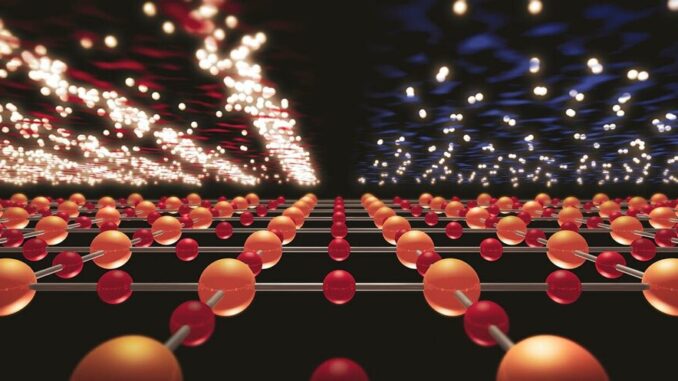
A new observe suggests that nickel oxide superconductors, which behavior power and not using a loss at better temperatures than traditional superconductors do, include a sort of quantum count referred to as fee density waves, or CDWs, that may accompany superconductivity.
The presence of CDWs suggests that those these days located substances, additionally referred to as nickelates, are able to forming correlated states — “electron soups” that may host loads of quantum levels, consisting of superconductivity, researchers from the Department of Energy’s SLAC National Accelerator Laboratory and Stanford University said in Nature Physics today.
“Unlike in every other superconductor we understand about, CDWs seem even earlier than we dope the cloth through changing a few atoms with others to alternate the quantity of electrons which might be unfastened to transport around,” stated Wei-Sheng Lee, a SLAC lead scientist and investigator with the Stanford Institute for Materials and Energy Science (SIMES) who led the observe.
“This makes the nickelates a totally exciting new gadget — a brand new playground for reading unconventional superconductors.”
Nickelates and cuprates
In the 35 years because the first unconventional “high-temperature” superconductors had been located, researchers were racing to discover one that might bring power and not using a loss at near room temperature. This could be a innovative development, permitting such things as flawlessly green strength lines, maglev trains and a number of different futuristic, energy-saving technologies.
But at the same time as a full of life international studies attempt has pinned down many factors in their nature and behavior, humans nonetheless do not know precisely how those substances come to be superconducting.
So the invention of nickelate’s superconducting powers through SIMES investigators 3 years in the past turned into thrilling as it gave scientists a sparkling angle at the problem.
Since then, SIMES researchers have explored the nickelates’ digital structure — essentially the manner their electrons behave — and magnetic behavior. These research grew to become up critical similarities and diffused variations among nickelates and the copper oxides or cuprates — the primary high-temperature superconductors ever located and nonetheless the arena document holders for high-temperature operation at ordinary pressures.
Since nickel and copper take a seat down proper subsequent to every different at the periodic desk of the elements, scientists had been now no longer amazed to peer a kinship there, and actually had suspected that nickelates would possibly make desirable superconductors. But it grew to become out to be distinctly tough to assemble substances with simply the proper characteristics.
“This continues to be very new,” Lee stated. “People are nonetheless suffering to synthesize skinny movies of those substances and apprehend how specific situations can have an effect on the underlying microscopic mechanisms associated with superconductivity.”
Frozen electron ripples
CDWs are simply one of the bizarre states of count that jostle for prominence in superconducting substances. You can consider them as a sample of frozen electron ripples superimposed at the cloth’s atomic structure, with a better density of electrons withinside the peaks of the ripples and a decrease density of electrons withinside the troughs.
As researchers regulate the cloth’s temperature and degree of doping, numerous states emerge and fade away. When situations are simply proper, the cloth’s electrons lose their character identities and shape an electron soup, and quantum states together with superconductivity and CDWs can emerge.
An in advance observe through the SIMES institution did now no longer discover CDWs in nickelates that include the rare-earth detail neodymium. But on this ultra-modern observe, the SIMES group created and tested a specific nickelate cloth in which neodymium turned into changed with some other rare-earth detail, lanthanum.
“The emergence of CDWs may be very touchy to such things as pressure or disease of their surroundings, which may be tuned through the use of specific rare-earth elements,” defined Matteo Rossi, who led the experiments at the same time as a postdoctoral researcher at SLAC.
The group performed experiments at 3 X-ray mild sources — the Diamond Light Source withinside the UK, the Stanford Synchrotron Radiation Lightsource at SLAC and the Advanced Light Source at DOE’s Lawrence Berkeley National Laboratory. Each of those centers provided specialised gear for probing and knowledge the cloth at a essential degree. All the experiments needed to be performed remotely due to pandemic restrictions.
‘Essentially self-doping’
The experiments confirmed that this nickelate may want to host each CDWs and superconducting states of count — and that those states had been gift even earlier than the cloth turned into doped. This turned into surprising, due to the fact doping is normally an important a part of getting substances to superconduct.
Lee stated the reality that this nickelate is basically self-doping makes it drastically specific from the cuprates.
“This makes nickelates a totally exciting new gadget for reading how those quantum levels compete or intertwine with every different,” he stated. “And it approach a variety of gear which might be used to observe different unconventional superconductors can be applicable to this one, too.”
Samples used on this observe had been synthesized withinside the lab of Stanford and SLAC Professor and SIMES Director Harold Hwang. Major investment got here from the DOE Office of Science. Stanford Synchrotron Radiation Lightsource and the Advanced Light Source are DOE Office of Science person centers.

Leave a Reply